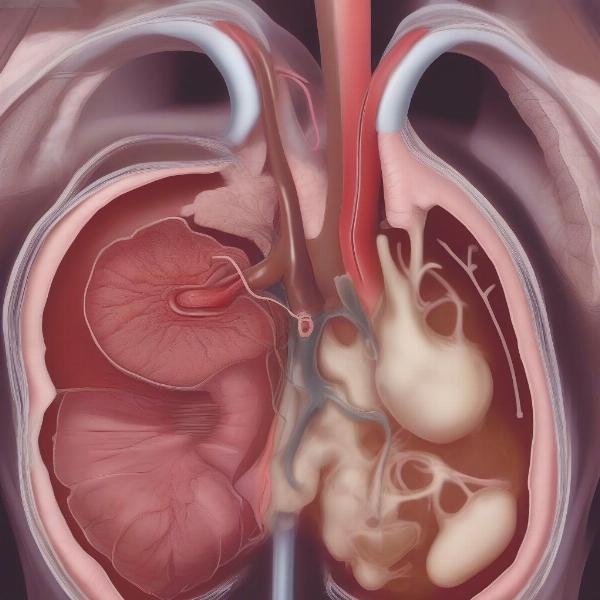Echocardiography, often referred to as an echo or cardiac ultrasound, is a vital diagnostic tool for evaluating heart health in dogs. This non-invasive procedure uses sound waves to create detailed images of the heart’s structure and function, allowing veterinarians to detect a wide range of heart conditions. Understanding what echocardiography entails can help dog owners make informed decisions about their pet’s health.
Understanding the Importance of Echocardiography for Dogs
Veterinarians may recommend an echocardiogram for dogs exhibiting symptoms like coughing, difficulty breathing, exercise intolerance, or fainting. It’s also crucial for breeds predisposed to certain heart diseases. Echocardiography can reveal valuable information about the heart’s chambers, valves, and blood flow, assisting in accurate diagnosis and treatment planning. Early detection through echocardiography is often key to managing heart conditions effectively and improving a dog’s quality of life.
What to Expect During a Canine Echocardiogram
The procedure itself is relatively straightforward and painless. Your dog will typically lie on their side while a veterinarian or veterinary technician applies a gel to their chest and moves a transducer over the area. The transducer emits sound waves that bounce off the heart, creating images displayed on a monitor. While some dogs might require mild sedation, most tolerate the procedure well without any discomfort. The entire process usually takes 30-60 minutes.
Interpreting the Results: What an Echocardiogram Can Reveal
An echocardiogram provides a wealth of information about the heart’s structure and function. It can identify abnormalities such as enlarged heart chambers, leaky valves, and defects in the heart walls. This information is crucial for diagnosing conditions like dilated cardiomyopathy, mitral valve disease, and congenital heart defects.
 Ultrasound image of a dog's heart
Ultrasound image of a dog's heart
“Echocardiography allows us to visualize the heart’s activity in real-time,” says Dr. Emily Carter, DVM, DACVIM (Cardiology). “This dynamic assessment is essential for understanding the severity of heart disease and tailoring treatment plans to each individual patient.”
Types of Echocardiography for Dogs
There are two main types of echocardiography: 2D and Doppler. 2D echocardiography provides still images of the heart’s structure, while Doppler echocardiography assesses blood flow through the heart. Both types offer valuable insights, and veterinarians often use them in conjunction to gain a comprehensive understanding of the heart’s health. Another type, M-mode echocardiography, allows for precise measurements of heart chamber size and wall thickness.
Caring for Your Dog After an Echocardiogram
After the procedure, your dog can typically resume normal activities. There are no special post-procedure care requirements, other than perhaps wiping away any residual gel from their chest. Your veterinarian will discuss the results of the echocardiogram with you and outline any necessary treatment or follow-up procedures.
Conclusion
Echocardiography in dogs is a valuable diagnostic tool for detecting and managing heart disease. This non-invasive procedure provides critical information about the heart’s structure and function, allowing for early diagnosis and tailored treatment plans. By understanding the benefits and procedure of echocardiography, dog owners can be proactive in safeguarding their pet’s cardiovascular health.
FAQ
-
Is echocardiography painful for dogs? No, echocardiography is a non-invasive and generally painless procedure.
-
Does my dog need to be sedated for an echocardiogram? Most dogs tolerate the procedure well without sedation, but some may require mild sedation.
-
How long does an echocardiogram take? The procedure typically takes 30-60 minutes.
-
What can an echocardiogram detect? It can detect various heart conditions, including enlarged heart chambers, valve disease, and congenital defects.
-
How much does an echocardiogram for a dog cost? The cost varies depending on location and clinic, but it’s typically a few hundred dollars.
-
What happens after the echocardiogram? Your veterinarian will discuss the results with you and recommend any necessary treatment or follow-up.
-
Where can I find a veterinarian who performs echocardiography? Many veterinary clinics and specialty hospitals offer echocardiography services.
ILM Dog is a leading international dog website dedicated to providing comprehensive information and resources for dog owners worldwide. We cover a wide range of topics, from breed selection and healthcare to training, nutrition, and grooming. We offer expert advice on various aspects of dog care, including health and medical care. For more information and assistance, please contact us via email at [email protected] or call us at +44 20-3965-8624. ILM Dog is committed to helping you provide the best possible care for your canine companion.